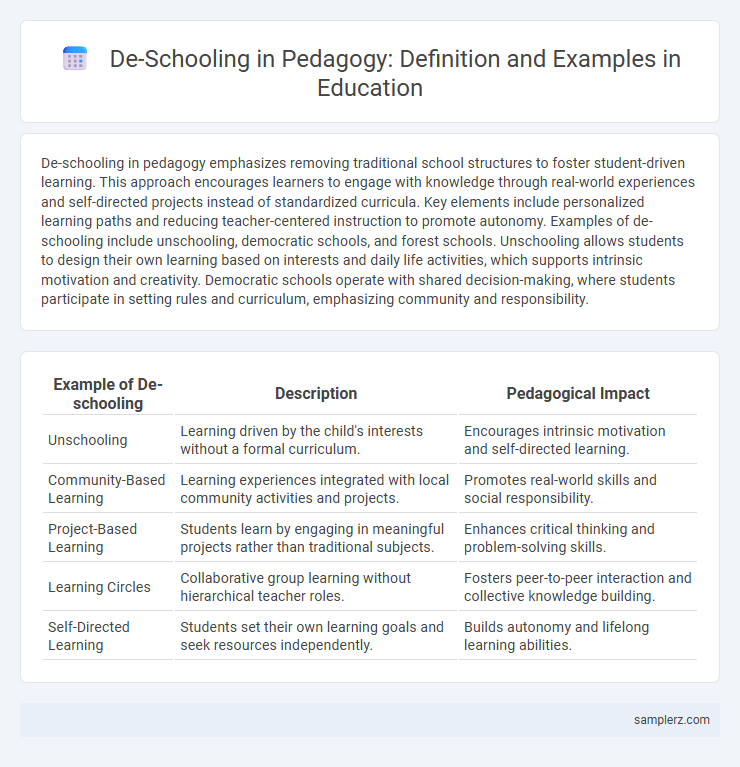De-schooling in pedagogy emphasizes removing traditional school structures to foster student-driven learning. This approach encourages learners to engage with knowledge through real-world experiences and self-directed projects instead of standardized curricula. Key elements include personalized learning paths and reducing teacher-centered instruction to promote autonomy. Examples of de-schooling include unschooling, democratic schools, and forest schools. Unschooling allows students to design their own learning based on interests and daily life activities, which supports intrinsic motivation and creativity. Democratic schools operate with shared decision-making, where students participate in setting rules and curriculum, emphasizing community and responsibility.
Table of Comparison
| Example of De-schooling | Description | Pedagogical Impact |
|---|---|---|
| Unschooling | Learning driven by the child's interests without a formal curriculum. | Encourages intrinsic motivation and self-directed learning. |
| Community-Based Learning | Learning experiences integrated with local community activities and projects. | Promotes real-world skills and social responsibility. |
| Project-Based Learning | Students learn by engaging in meaningful projects rather than traditional subjects. | Enhances critical thinking and problem-solving skills. |
| Learning Circles | Collaborative group learning without hierarchical teacher roles. | Fosters peer-to-peer interaction and collective knowledge building. |
| Self-Directed Learning | Students set their own learning goals and seek resources independently. | Builds autonomy and lifelong learning abilities. |
Understanding De-Schooling: A Paradigm Shift in Pedagogy
De-schooling in pedagogy emphasizes learner autonomy by replacing traditional classrooms with self-directed educational environments, exemplified by unschooling approaches where students explore subjects driven by personal interests rather than standardized curricula. This paradigm shift challenges conventional assessment methods, favoring portfolio evaluations and experiential learning to foster critical thinking and creativity. Embracing de-schooling transforms educational systems, promoting flexibility and intrinsic motivation tailored to individual developmental needs.
Key Principles of De-Schooling in Educational Practice
De-schooling in pedagogy emphasizes learner autonomy, fostering intrinsic motivation by allowing students to explore subjects based on individual interests rather than rigid curricula. This approach encourages the dismantling of traditional hierarchical teacher-student roles, promoting collaborative knowledge construction. Key principles include flexible learning environments, self-directed inquiry, and a rejection of standardized testing, aiming to cultivate critical thinking and lifelong learning skills.
Historical Examples of De-Schooling Initiatives
The Summerhill School, founded by A.S. Neill in 1921, exemplifies early de-schooling by promoting child-centered learning and voluntary attendance, challenging traditional compulsory education norms. Ivan Illich's 1971 book, "Deschooling Society," inspired numerous community-driven learning networks that dismantled formal school structures in favor of self-directed education. The Sudbury Valley School, established in 1968, operates on a democratic model where students govern their environment, embodying principles of de-schooling through autonomy and freedom in learning.
Innovative De-Schooling Methods in Modern Classrooms
Innovative de-schooling methods in modern classrooms include project-based learning, where students engage in real-world tasks that promote critical thinking and collaboration. The Sudbury model exemplifies this approach by allowing learners complete autonomy over their education, fostering intrinsic motivation and personalized growth. Incorporating experiential learning and democratic decision-making redefines traditional hierarchies, creating an environment that prioritizes student agency and creativity.
Community-Based Learning as a Model of De-Schooling
Community-Based Learning exemplifies de-schooling by shifting education from traditional classrooms to real-world environments where learners engage directly with their communities. This model emphasizes experiential knowledge, social interaction, and practical skills development outside institutional boundaries. It fosters autonomy and critical thinking by prioritizing local context and collaborative problem-solving over standardized curricula.
Technology-Driven De-Schooling: Digital Learning Spaces
Technology-driven de-schooling transforms traditional education by replacing physical classrooms with digital learning spaces, enabling personalized and self-paced education. Platforms like Khan Academy and Coursera exemplify this shift, providing free or affordable access to diverse subjects anytime, anywhere. This approach fosters learner autonomy and breaks down geographical and socio-economic barriers, promoting inclusive and flexible education models.
Case Studies: Success Stories in De-Schooling Education
Case studies in de-schooling education highlight successes such as Sudbury Valley School, where students direct their own learning without formal curricula, fostering intrinsic motivation and critical thinking skills. Another example, the Summerhill School, emphasizes democratic governance and emotional development, resulting in higher student engagement and well-being. These models demonstrate how de-schooling pedagogies promote personalized education, autonomy, and lifelong learning capacity.
De-Schooling and Student-Centered Learning Approaches
De-schooling in pedagogy emphasizes dismantling traditional classroom hierarchies to foster student autonomy and intrinsic motivation, illustrated by educational models like Sudbury schools where learners direct their own educational journeys. Student-centered learning approaches prioritize personalized instruction, active engagement, and collaborative problem-solving, often employing project-based learning and inquiry-driven methods to adapt to individual interests and learning styles. These approaches collectively shift the role of educators from authoritative instructors to facilitators, promoting critical thinking, self-regulation, and lifelong learning skills.
Overcoming Challenges in Implementing De-Schooling
Implementing de-schooling in pedagogy often faces challenges such as resistance from traditional educational institutions and the need for extensive mindset shifts among educators and parents. Overcoming these challenges requires fostering collaborative learning environments, integrating flexible curricula, and promoting learner autonomy to align with the principles of unschooling and self-directed education. Case studies from progressive schools demonstrate that continuous dialogue, community involvement, and adaptive assessment methods are critical for successful de-schooling adoption.
The Future of De-Schooling in Global Education Systems
De-schooling in pedagogy emphasizes learner autonomy, replacing traditional classroom constraints with personalized, interest-driven education models. Global education systems increasingly integrate technology, project-based learning, and community engagement to foster critical thinking and adaptability. This shift encourages lifelong learning skills, preparing students for diverse, dynamic future challenges.

example of de-schooling in pedagogy Infographic
 samplerz.com
samplerz.com